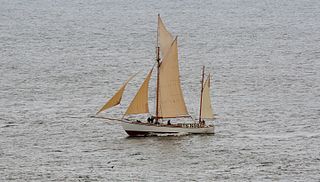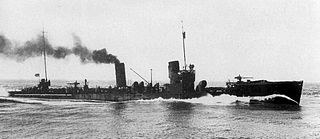
HMS Erebus was a First World War monitor launched on 19 June 1916 and which served in both world wars. She and her sister ship Terror are known as the Erebus class. They were named after the two bomb vessels sent to investigate the Northwest Passage as part of Franklin's lost expedition (1845–1848), in which all 129 members eventually perished.

USS Nicholson was an O'Brien-class destroyer built for the United States Navy before the American entry into World War I. The ship was the second U.S. Navy vessel named in honor of five members of the Nicholson family who rendered distinguished service in the American Revolutionary War, the War of 1812, and the American Civil War: brothers James, Samuel, and John Nicholson; William Nicholson, son of John; and James W. Nicholson, grandson of Samuel.

German submarine U-49 was a Type VIIB U-boat of Nazi Germany's Kriegsmarine during World War II. She was ordered on 21 November 1936 and laid down on 15 September 1938 at the yards of Friedrich Krupp Germaniawerft AG in Kiel as yard number 584. Launched on 24 June 1939, she was commissioned on 12 August and assigned to the 7th U-Boat Flotilla under the command of Kurt von Goßler.

SM UB-5 was a German Type UB I submarine or U-boat in the Imperial German Navy during World War I. She sank five ships during her career and was broken up in Germany in 1919.

SMS Kaiser Barbarossa was a German pre-dreadnought battleship of the Kaiser Friedrich III class. The ship was built for the Imperial Navy, which had begun a program of expansion at the direction of Kaiser Wilhelm II. Construction took place at Schichau, in Danzig. Kaiser Barbarossa was laid down in August 1898, launched on 21 April 1900, and commissioned in June 1901. The ship was armed with a main battery of four 24-centimeter (9.4 in) guns in two twin-gun turrets.

SMS Kaiser Karl der Grosse was a German pre-dreadnought battleship of the Kaiser Friedrich III class, built around the turn of the 20th century for the Kaiserliche Marine. Named for the Emperor Charlemagne, Kaiser Karl der Grosse was built in Hamburg, at the Blohm and Voss shipyard. She was laid down in September 1898 and launched in October 1899. A shipyard strike and an accidental grounding delayed her completion until February 1902; she was therefore the last member of her class to enter service. The ship was armed with four 24-centimeter (9.4 in) guns in two twin gun turrets and had a top speed of 17.5 knots.
SM UB-17 was a German Type UB I submarine or U-boat in the German Imperial Navy during World War I. The submarine disappeared during a patrol in March 1918.

Kommuna is a submarine rescue ship in service with the Russian Navy's Black Sea Fleet and the world's oldest active duty naval vessel.

Wyvern is a 60-foot (18 m) open sea sailing ship operated by Stavanger Maritime Museum. The ship was designed by Colin Archer on a commission from British-born Frederick Croft and was launched on 10 August 1897. She sailed under the German flag from 1909. The Norwegian newspaper editor Rolf Thommessen bought her in 1924 and renamed her Havfruen III. This name was kept by the English owners, Anne and Terrence Carr, who acquired her in 1947 and sold her to Christian-Frederick Mattner in 1970, who renamed her to the original name "Wyvern".
The Cemfjord was a Cyprus-registered cargo ship which foundered in the Pentland Firth off the north-east coast of Scotland on 2 January 2015. Built as the general cargo ship Margareta in 1984, she was converted to carry cement in 1998 and was en route from Aalborg, Denmark to Runcorn, Cheshire, United Kingdom when she capsized in bad weather and sank in 82 metres (270 ft) of water. All eight crew were presumed lost. No bodies were recovered, and the ship has been left as a sea grave.
Adolf Vinnen was a weather ship that was built in 1929 as the fishing vessel Gustav Adolf Kühling. She was renamed in 1930. The ship was requisitioned by the Kriegsmarine in March 1940, serving until 23 October 1940 when she was sunk by HMS Matabele, HMS Punjabi and HMS Somali.
SS Oslo was a British passenger ship that was torpedoed by the German submarine SM U-87 in the North Sea 15 nautical miles (28 km) east by north of the Out Skerries, Shetland Islands. She was travelling from Trondheim, Norway to Liverpool, United Kingdom while carrying passengers and a cargo of copper ore.

The B 97 class was a class of eight destroyers built for and operated by the Imperial German Navy during the First World War. They served throughout the war, with one being lost in 1915, five being scuttled at Scapa Flow in 1919 and one being transferred to Italy, where it remained in use until 1939.
SS Rotterdam was a Dutch Passenger ship that ran aground and sunk on the Zeehondenbank near the Dutch island of Schouwen, while she was travelling from New York, United States to Rotterdam, The Netherlands.
ML-18 was a British motor launch boat that disappeared in the North Sea while on passage from Norway.
ML-191 was a British motor launch boat that disappeared in the North Sea while on passage from Norway.
SMS S32 was a V25-class large torpedo boat of the Imperial German Navy that served during the First World War. She was built by the Schichau-Werke shipyard in Elbing, East Prussia, being launched on 28 February 1914 and was completed in September that year.

SMS V43 was a V25-class Large Torpedo Boat of the Imperial German Navy, that served during the First World War. V43 was built by AG Vulcan at their Stettin shipyard from 1914–1915, entering service on 28 May that year. V43 took part in operations in the North Sea, the English Channel and the Baltic Sea. She survived the war, and was interned at Scapa Flow, surviving the Scuttling of the German fleet at Scapa Flow. V43 was allocated to the US Navy, and was sunk as a target on 15 July 1921.
SS Rastrello was an Italian cargo ship that was sunk in a British air raid on 16 June 1940 in Naples, Italy.
SS Uniwaleco was a South-African Whale Factory ship that was torpedoed by the German submarine U-161 in the Caribbean Sea 45 nautical miles (83 km) west of the Saint Vincent Passage on 7 March 1942 while she was travelling from Curaçao to Freetown with a stopover in Trinidad while carrying a cargo of 8800 tons of fuel oil.









